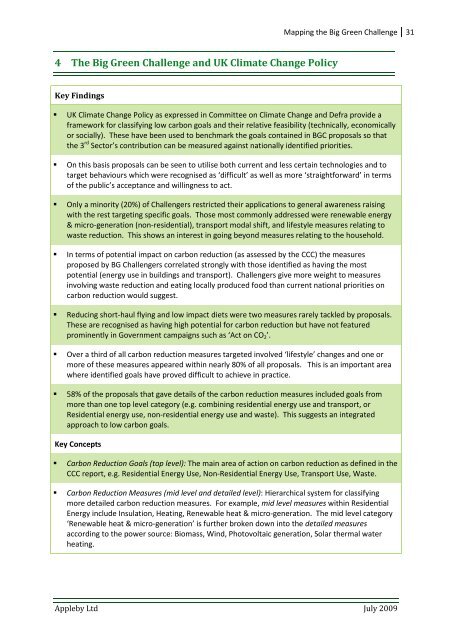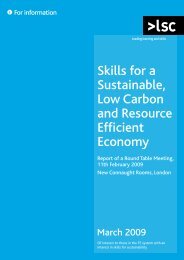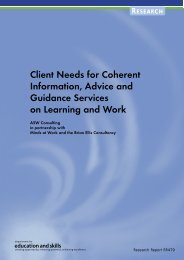Mapping the Big Green Challenge - The Skills & Learning ...
Mapping the Big Green Challenge - The Skills & Learning ...
Mapping the Big Green Challenge - The Skills & Learning ...
Create successful ePaper yourself
Turn your PDF publications into a flip-book with our unique Google optimized e-Paper software.
<strong>Mapping</strong> <strong>the</strong> <strong>Big</strong> <strong>Green</strong> <strong>Challenge</strong> 314 <strong>The</strong> <strong>Big</strong> <strong>Green</strong> <strong>Challenge</strong> and UK Climate Change PolicyKey FindingsUK Climate Change Policy as expressed in Committee on Climate Change and Defra provide aframework for classifying low carbon goals and <strong>the</strong>ir relative feasibility (technically, economicallyor socially). <strong>The</strong>se have been used to benchmark <strong>the</strong> goals contained in BGC proposals so that<strong>the</strong> 3 rd Sector’s contribution can be measured against nationally identified priorities.On this basis proposals can be seen to utilise both current and less certain technologies and totarget behaviours which were recognised as ‘difficult’ as well as more ‘straightforward’ in termsof <strong>the</strong> public’s acceptance and willingness to act.Only a minority (20%) of <strong>Challenge</strong>rs restricted <strong>the</strong>ir applications to general awareness raisingwith <strong>the</strong> rest targeting specific goals. Those most commonly addressed were renewable energy& micro-generation (non-residential), transport modal shift, and lifestyle measures relating towaste reduction. This shows an interest in going beyond measures relating to <strong>the</strong> household.In terms of potential impact on carbon reduction (as assessed by <strong>the</strong> CCC) <strong>the</strong> measuresproposed by BG <strong>Challenge</strong>rs correlated strongly with those identified as having <strong>the</strong> mostpotential (energy use in buildings and transport). <strong>Challenge</strong>rs give more weight to measuresinvolving waste reduction and eating locally produced food than current national priorities oncarbon reduction would suggest.Reducing short-haul flying and low impact diets were two measures rarely tackled by proposals.<strong>The</strong>se are recognised as having high potential for carbon reduction but have not featuredprominently in Government campaigns such as ‘Act on CO 2 ’.Over a third of all carbon reduction measures targeted involved ‘lifestyle’ changes and one ormore of <strong>the</strong>se measures appeared within nearly 80% of all proposals. This is an important areawhere identified goals have proved difficult to achieve in practice.58% of <strong>the</strong> proposals that gave details of <strong>the</strong> carbon reduction measures included goals frommore than one top level category (e.g. combining residential energy use and transport, orResidential energy use, non-residential energy use and waste). This suggests an integratedapproach to low carbon goals.Key ConceptsCarbon Reduction Goals (top level): <strong>The</strong> main area of action on carbon reduction as defined in <strong>the</strong>CCC report, e.g. Residential Energy Use, Non-Residential Energy Use, Transport Use, Waste.Carbon Reduction Measures (mid level and detailed level): Hierarchical system for classifyingmore detailed carbon reduction measures. For example, mid level measures within ResidentialEnergy include Insulation, Heating, Renewable heat & micro-generation. <strong>The</strong> mid level category‘Renewable heat & micro-generation’ is fur<strong>the</strong>r broken down into <strong>the</strong> detailed measuresaccording to <strong>the</strong> power source: Biomass, Wind, Photovoltaic generation, Solar <strong>the</strong>rmal waterheating.Appleby Ltd July 2009











